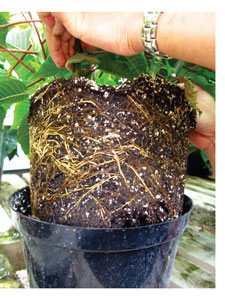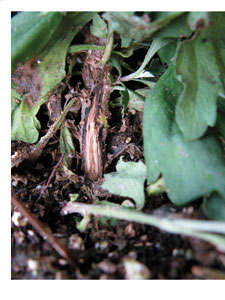11/24/2010
Pythium Root Rot of Herbaceous Plants
Janna Beckerman
Pythium is a regularly encountered disease problem in greenhouses nationwide, and has the well-deserved reputation of being a ruthless pathogen.
Pythium spp. primarily attacks plant roots, but also causes cutting rots, stem rots and foliar blight under the right conditions.
The three most commonly encountered species of root-rotting Pythium species in the greenhouse industry are
Pythium irregulare,
Pythium ultimum, and
Pythium aphanidermatum. The two most commonly encountered species,
P. ultimum and
P. irregulare, are ubiquitous pathogens regularly found in the field, sand, pond and stream water, and decomposing vegetation. Identifying which Pythium is causing the problem in your greenhouse is important as some Pythiums, like
P. ultimum, have very wide host ranges. Also, which species of Pythium you have may dictate when damage will occur: Infection by
P. aphanidermatum occurs more often at higher temperatures (above 77F/25C), whereas
P. ultimum diseases are most serious when temperatures are below 68F (20C). These different Pythium infections are often seen early in poinsettia production under hot weather (by
P. aphanidermatum), and then again towards the end of production with the cooler temperatures by
P. ultimum.
All Pythiums favor wet conditions with high soil-soluble salts in the potting medium. Pythium is found contaminating commercially available soilless potting mixes, and readily contaminates sterilized soil or soilless mixes by the careless use of dirty tools, containers and proximity to previously infected plants or media. Fungus gnats and shore flies have been shown to vector Pythium within greenhouses.
 Symptoms
Symptoms
Root rot symptoms, regardless of the pathogen, are surprisingly similar. The first symptoms of Pythium infection include stunting; however, careful examination of root tips early in the infection will show only dead tips. With Pythium root rots, roots appear water-soaked, and the root cortex easily sloughs off leaving a strand of vascular tissue. This is not a conclusive symptom, but one to note. On the stems of cuttings, a soft, watery rot may develop. Key signs include the cells of the plant root containing round, thick-walled oospores and/or round zoosporangium. An accurate diagnosis of this disease is essential as fungicides labeled to control other root rots (e.g., thielaviopsis, fusarium, rhizoctonia) will not be effective against Pythium root rot.
Management
Keep it clean. Surface clean and disinfect all bench surfaces, tools, trays, containers and equipment that will contact the potting mix; use high-quality cuttings, and remove immediately any cuttings or plants that show symptoms of disease.
Media-wise. Cover and store soilless mixes in an area that will not be contaminated. Peat-vermiculite potting mix often suffer from high soluble salts, with plants developing root injury that predisposes them to Pythium. Media with a moisture holding capacity above 70% has been reported to seriously increase damage from
P. ultimum, and the use of highly decomposed (dark) peat results in worse Pythium root rot compared to non-decomposed medium or light peat.
Water and fertilize correctly. Overwatering and over-fertilization increases rates of infection by Pythium. In addition to overwatering, the use of poorly draining medium, or the placement of pots or flats in standing water, will also affect drainage and predispose plants to infection by Pythium. Excess watering also creates conditions conducive for shore flies and fungus gnats, which feed on roots and damage them, providing an infection court for Pythium. These insects are also effective vectors of the pathogen, spreading the disease throughout the greenhouse or growing area. Pythium diseases are also more severe on over-fertilized plants. The cause of this damage is two-fold: Excess nitrogen suppresses the natural defensive response of the plant, and the accumulation of salts in the growing medium damages root tips, providing an easy means for Pythium to infect.
When using pond or stream water for irrigation, place the intake pipe well above the bottom of the pond so sediment is not drawn in, but also make sure the pipe isn’t near the surface, either. If Pythium contamination is a problem, slow sand filtration is an effective method for removing Pythium (and other plant pathogens) from recycled water. Other water treatment options include ultraviolet radiation, ozonation and chlorination.
Plan ahead. History is also useful for predicting the future! If you’ve had problems in the past with Pythium, be pro-active to prevent outbreaks. Biological control agents such as
Trichoderma harzianum or
Gliocladium virens do provide some protection when disease pressures are low; however, overwatering or excessive fertilization will reduce their efficacy to the point where severe outbreaks of Pythium can occur despite the use of biological controls. If severe outbreaks have occurred in the past, consider incorporating a granular fungicide (i.e., Banrot 8G) in your potting mix.
Prevention is the key to managing this disease, as Pythium root rot is difficult to control once rot has begun.
Chemical controls
Numerous fungicides are labeled for Pythium control. All of these provide the best result if applied to prevent infection from occurring. Growers should regularly scout their greenhouse for disease, confirm diagnosis, and quickly provide an effective fungicide program to minimize losses from this disease.
Developing an effective program is challenging, and growers must recognize that misuse of these fungicides (and some very adaptable Pythiums) has resulted in fungicide resistance. In work done by Moorman et al., 2002, almost 40% of the
P. aphanidermatum and
P. irregulare isolates were found to be resistant to mefenoxam; this is important because these two species were encountered in 74% of all Pythium cases from 1996 through 2001 in Pennsylvania. If Subdue Maxx or other chemicals don’t appear to be protecting your plants, switch to another product.
Fungicide application for control of Pythium works best when applied as a protectant. Table 1 presents a list of fungicides labeled for disease control. When developing a fungicide rotation, be sure to choose fungicides that have different FRAC codes to minimize the risk of fungicide resistance developing in your greenhouse.
GT
References: Martin, Frank N. and Loper, Joyce E. (1999). Soilborne Plant Diseases Caused by Pythium spp.: Ecology, Epidemiology, and Prospects for Biological Control.
Critical Reviews in Plant Sciences, 18:111-181.
Moorman, G. W., Kang, S., Geiser, D. M., and Kim, S. H. 2002. Identification and characterization of Pythium species associated with greenhouse floral crops in Pennsylvania.
Plant Dis. 86:1227-1231.
Janna Beckerman is assistant professor and extension plant pathologist in the Department of Botany and Plant Pathology at Purdue University.